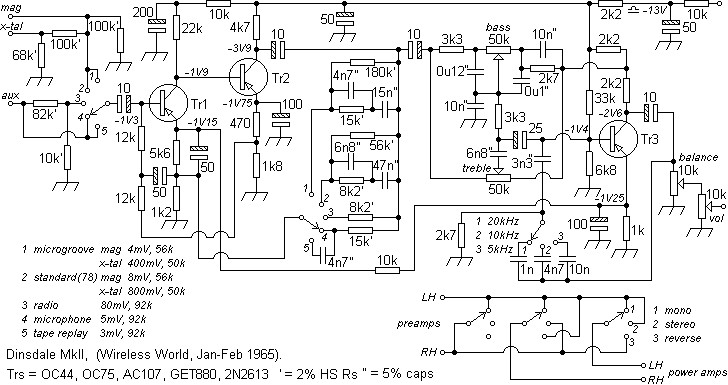
PreampsInformation is sometimes requested concerning stereo preamps. Since interest revolves around the reproduction of 12" vinyl (or acetate) a few AC-coupled, single supply designs from the sixties and seventies are covered here. Any criticisms voiced are in no way intended to detract from the designer's efforts. For example, that for the Dinsdale Mk II broke ground and identified the fundamental structure that would be followed thereafter.

An input selector feeds a signal conditioner which is followed by tone controls, filter, balance, volume and a channel selector that would best be placed before the balance control. It must be borne in mind that although a tape input was accommodated, no provision for a tape output was made. This would be best taken from the input to the tone controls.The unavoidable use of, usually silver-plated brass, switch contacts to achieve a flexible, multi-functional aspect can only lead to noise when dirty or worn, especially if used in signal and feedback paths. Momentary open circuits as the function is switched could give rise to startling sound effects. The main source of noise in this format, usually followed by the supply. Some much later designs, like B&O, would include a PA mute operated by a switch ganged with the selector bank.
John Linsley Hood built his 1969 modular preamp 'with the separate units laid out in mirror image form, as a stereo pair on a single 4in X 4¾in s.r.b.p. pin board'. This was usually matched with the class A amplifier of the same year.
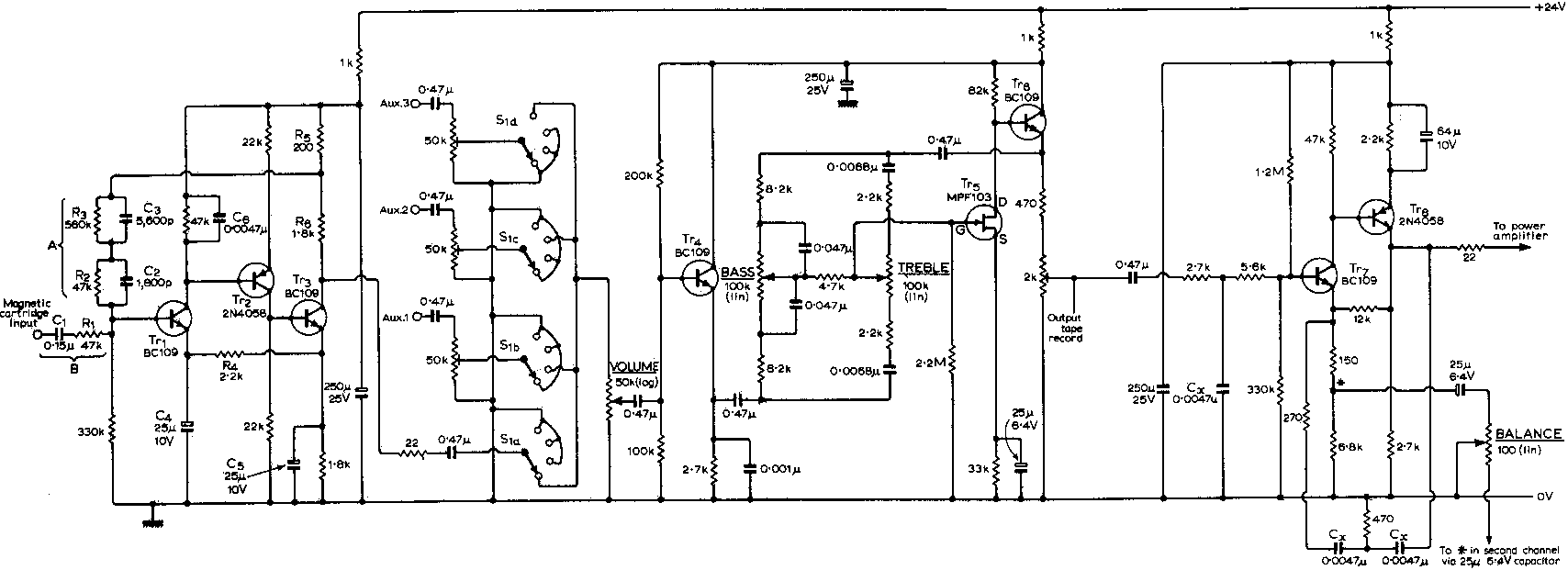
Using the presets before the selector, the user could set the levels of the inputs to match those of the quietest. Annoying differences in conventions (DIN/RCA) or nonstandard inputs could then be accommodated. Note how unused switch arms are grounded to reduce crosstalk. To avoid distortion the signal at the tone controls is some 60-100mV (2Vrms output available, <0.03%THD). The tape output should be taken from before the tone controls. The low-pass filter gives a roll-off (with the values given) of 12dB/octave @ 18kHz, increasing to 18dB/octave with it's input RC network. Residual noise from the preamp would be reduced if the volume control was placed on the output.JLH modded the RIAA, which was built into the record-deck; 'These changes maintain the velocity response flat down to 25Hz, with rapid attenuation below this frequency. [Acknowledging the rumble inherent in many decks. PK] Unfortunately the mid point gain of the circuit is reduced to 5, and some additional amplification is therefore needed if it is desired to avoid working with the tone control circuit at the 20mV level. The simple floating emitter collector-follower circuit (below) is therefore interposed, without coupling capacitors, between the output series resistor and the collector of Tr3. The distortion contributed by this is less than 0.05%.'
Ceramic cartridges could be accommodated with additional input and feedback network changes to the RIAA stage or an impedance converter stage could be used.This design (as did the later ones shown below, bar the Radford) used the DIN connector convention whose low-voltage, high impedance characteristic was often a cause of poor signal-to-noise ratios (later JLH preamp designs). Care was taken over reducing supply noise, the supply rail being zener stabilised with each stage decoupled by it's own RC network, giving each stage an operating differential of about 15V. Relatively simple techniques can be used to dramatically improve supply noise and crosstalk and are recommended. The 75W Powertran kit used a 'Liniac' preamp with a 'mode' switch and switched range tone control with variable slope filter (PDF available). It must be understood that a mono switch will negate the action of any balance control that precedes it.
RF breakthrough on an input can be reduced if the earth side of each socket is grounded directly to chassis via a low value (10nF) ceramic capacitor.
Gibb's and Shaw's 1970/1 PE Gemini caught the eye, being compared favourably with the Quad 33 and 303, of about the same date.
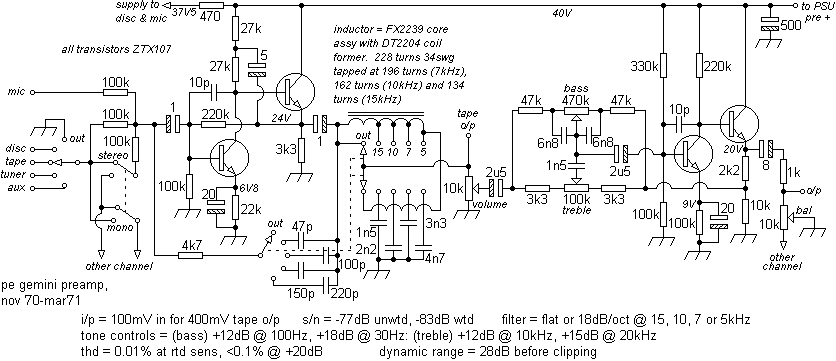
Personal preference here would move the tape output to the other side of the treble filter coil, and the volume control to the output. A PCB redesign could have accommodated the controls, thus reducing the extensive wiring that many amplifiers entailed.Below is the preamp suggested in a SL403A IC application which must represent one of the earliest examples of IC op-amps being used in a 'hi-fi' preamp.
Notable is the additional switch wafer, compared to other approaches. Specs were surprisingly good and would withstand comparison today.
The use of IC opamps considerably reduces the component count. The NE5534 has been a personal favourite for audio over many years and On Semiconductor's AND8177/D application note gives a good range of designs, although be mindful of the numerous errors that it (Rev. 0) contains (some RIAA and equalisation solutions).H. P. Walker's 'Stereo Mixer' modules (WW, May 1971) and 'Low-noise Audio Amplifiers' (WW, May 1972) produced a number of useful designs and are recommended.
Quad represented quality design and construction. However, an overcomplex design can increase the component count that there is to fail, or the number of dry joints if soldering quality (a vital component) is not good.
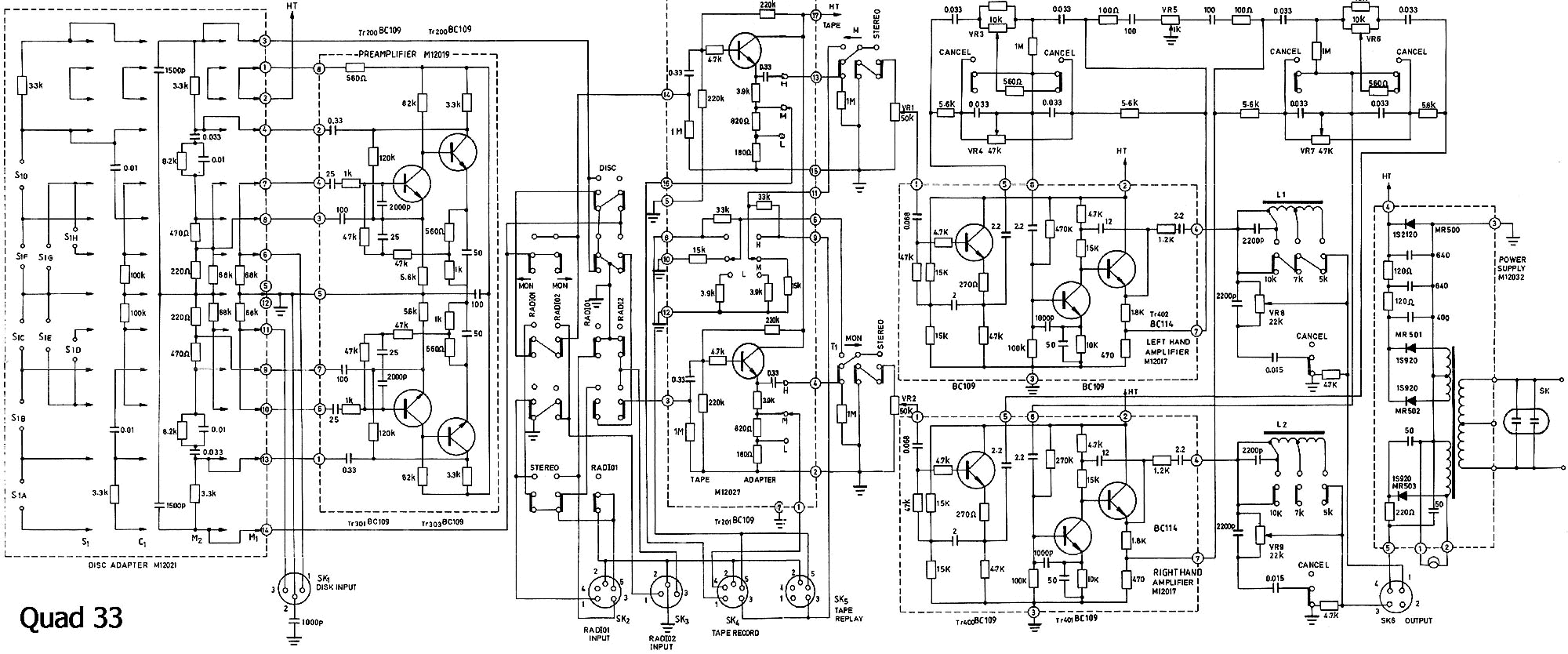
Note reliance on large number of switch contacts (note dissimilarities on switches serving L1 and L2, and the interesting transistor designations!) and interconnections. Although the later 34 preamp was nice to look at, one never quite understood why the mono switch, despite convention and previous designs, was moved to the middle of both slope filters, after the volume, tone, balance controls and filters.To reduce switch contact noise diode-switching was introduced by some manufacturers. Considered innovative at the time, this was only really useful for DIN signal levels and was unable to cope with larger voltages whose noise floor was comparatively much lower. With damped switching, like that shown below, sources would ‘cross fade’ as the diode voltages changed providing a more pleasant and less abrupt change, particularly if the newly selected input was comparatively loud.
The Lecson AC1 (usually matched to the AP3 MkII power amplifier) truly landed from another planet in that
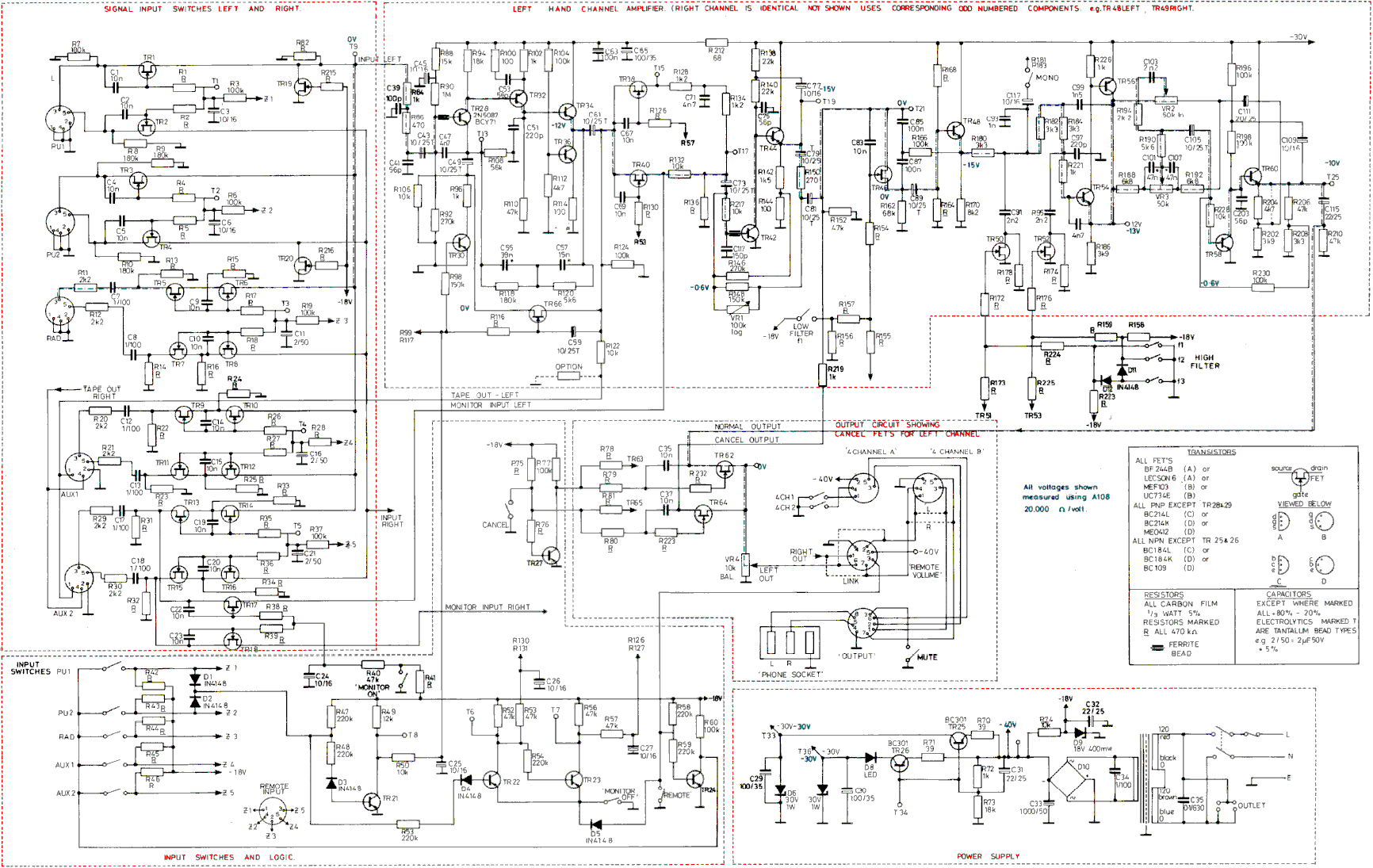
virtually all signal and conditioning paths were switched by FETs and amplification/eq was confined to a single double-sided board. Internally, the AC1 remained unchanged most of it's life. The first batch had tops made from strips of thin glass. Attractive but impractical, the glass was quickly replaced by a one piece acrylic top which was screen-printed. Minor changes and component variations were made but essentially it performed well apart from the rather poor headroom of the phono cartridge input. It is said that the two production managers both hated the product because it was hard to manufacture needing selection of FETs and tantalum capacitors; a lot of mechanical adjustment (switches were reed types actuated by magnets) and with acrylic tops that marked easily so that there were too many rejects.The Radford HD250 and ZD22, whilst claiming otherwise, unfortunately offered poor performance for the effort that had gone into the design which contained a number of flaws, and the bane of the audio enthusiast, mechanical contacts. Lots of them. The RCA phono connector convention, however, was supported.

Slider controls were fashionable, but ingress of dust could cause problems. Rotary controls are seen as ergonomically pleasing and easier to use, thus the slider's decline.Curtis' P60 offered another 'quality' approach which many owner-users reported returning to when dissatisfied with more modern offerings.

Note how inputs were shorted to ground as with the JLH above. All coupling capacitors were tied to ground, prior to switching, to reduce transients arising from leakage. The large PCB reduced wiring considerably, the standard of finish was high and innovative additions were made, especially in respect of protection.The facility to use more than one (3) tape deck was useful. Later designs would include separate (pre-filter) record selector switching so that recordings could be made from sources other than those being listened to, eg; tape-to-tape, a long overdue improvement from a tape enthusiast's view.
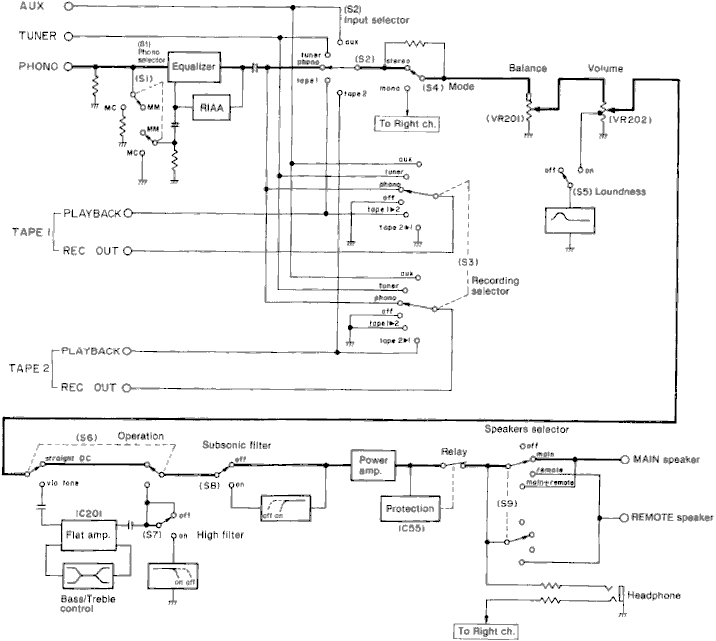
There is an argument for using a separate buffer stage to supply signals to tape outputs since a low (comparatively speaking) load can adversely affect, say, an RIAA stage's output filter.At the design stage, consideration can be given to running one or more pairs of headphones, always useful if one wants to listen to music without the main PA.
A rarely seen, but useful facility on an integrated amplifier is a break-jack between the preamp proper and the power amp. This enabled, say, a graphic equaliser to be inserted, or an electronic crossover added, with additional amplifiers and speakers increasing flexibility, as in the Hitachi HA-7700, the extensive Sony TA-8650 or the less complex Technics SA-700 (below).

A much earlier design noted for it's flexibility by enthusiasts was the Trio/Kenwood KA4002 despite the limitations of it's output stages and again the many mechanical contacts involved.Stan Curtis' System A (copies of scans of original article available on request) used a modular approach to meet individual needs and 'discrete component operational amplifier's using selected devices. A tape output selector switch can offer flexibility and a conventional balance control with fixed output stage gains will reduce problems with a noisy pot.
For most needs there is nothing wrong, today, with an arrangement of the LM381, a veteran preamp IC, such 'building blocks' reducing component count and thus complexity. Cross-talk issues can be resolved by using one IC per channel. A buffer can then drive a passive tone/volume network and a gain block is available either for another buffer or for EQ, say (B&O RIAA application). Run at a well regulated and smoothed 30V. As noted above, flexibility and therefore usefulness is enhanced with extended and considered switching arrangements. Multiple variable inputs can be useful.
Bass will be extended if the 22µF cap in the feedback loop is increased, but with values given should meet most rumble and speaker needs. The LM382 reduces component count with on-chip resistors and the LM387 offers a smaller package (8 dil) with reduced spec and can only be used in differential mode without external compensation.The respected HA12017 was used in the Armstrong 730 which is worth a look. Other types like the TDA3410 can be useful. This was intended for tape decks and has two channels each consisting of a 30dB gain block (2Vpk-pk max out) with dual input switching followed by an opamp. Used as a 60dB gain stage this IC can deliver a 0.5dB response from 25Hz to 20kHz with <0.05% THD with a signal-to-noise ratio better than 65dB.
A simple voltage/resistance-controlled electronic attenuator can be provided by the MC3340P but distortion can rise to 3% at maximum attenuation levels. The NE570/1 dual channel compander can provide a gain of between +6dB and -80db with a 12V control voltage.
A couple of suggestions for electronic control can be found here. In response to requests for guitar preamps, a couple of scans of (elektor) self-build projects are available on request. Alternatively, "Solid-state guitar amplifiers" by Teemu Kyttala is an excellent source.
equalisation | sundry styli interfaces | electronic switching Contact me at paulkemble@hotmail.com
especially if you want additional content to this page
or if you find any links that don't work. Don't forget
to add the page title or URL. Take care!
Back to index, sound, tips or home.